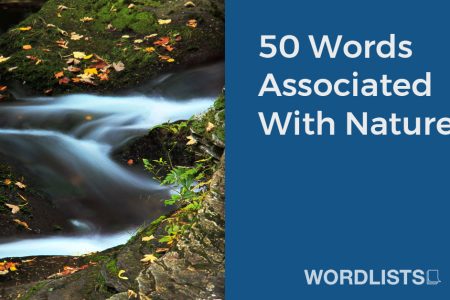Nature is all around us, from the trees in our backyard to the mountains in the distance. It’s a source of beauty, inspiration, and wonder, and there are many words associated with nature that help us describe and experience it.
From terms for different types of natural environments and phenomena to words that describe the beauty and power of the natural world, this list of 50 words will help you fully appreciate the wonders of nature.

Subscribe to our mailing list to receive FREE exclusive content and offers!
50 Words Associated With Nature Meanings
Forest: A large area covered predominantly by trees and undergrowth. Forests play a critical role in balancing the earth’s ecosystem.
Tree: A perennial plant with an elongated stem, or trunk, that supports branches and leaves. Trees are crucial for producing oxygen and sequestering carbon dioxide.
Leaf: The main organ of photosynthesis and transpiration in higher plants. It’s usually green and absorbs sunlight to convert into energy.
Wood: The dense, hard, fibrous substance located beneath the bark in trees. It’s commonly used as a building material and as a fuel source.
Bark: The protective outer layer that covers the trunk, branches, and roots of a tree. It serves as a protective barrier against environmental threats.
Flower: The reproductive structure found in flowering plants. It’s often colorful and fragrant, attracting pollinators to help with fertilization.
Grass: A group of plant species that includes lawns and pastures. They are known for their long, slender leaves.
Plant: A living organism that photosynthesizes sunlight into energy, typically characterized by green leaves, roots, and growth in soil.
Bush: A shrub or small tree that is usually smaller than typical trees and has many branches rising from the ground.
Garden: A planned space, usually outdoors, set aside for the display, cultivation, or enjoyment of plants and other forms of nature.
Meadow: A field habitat vegetated by grass, herbs, and other non-woody plants. Meadows are often home to a rich array of wildlife.
Field: An open land area free of woods and buildings, often used for growing crops or grazing livestock.
Mountain: A large natural elevation of the earth’s surface, usually formed as a result of tectonic forces or volcanism.
Valley: A low area between hills or mountains typically with a river running through it. Valleys often have fertile soils suitable for agriculture.
Canyon: A deep, narrow valley with steep sides, often carved from the landscape by a river.
Cliff: A steep rock face, usually at the edge of the sea, a river, or between levels of land on a hillside.
Rock: A naturally occurring solid composed of minerals. Rocks are the building blocks of the Earth’s crust.
Boulder: A large rock, usually over 10 inches in diameter, that has been worn smooth by erosion and weathering.
Soil: A mixture of organic matter, minerals, gases, liquids, and organisms that together support life. Soil is essential for plant growth and water filtration.
Dirt: Loose soil or earth; the ground. While it can be fertile, it’s often regarded as unclean or unwanted material.
Sand: A loose granular substance, resulting from the erosion of siliceous and other rocks, often found on beaches and in deserts.
Beach: A landform alongside a body of water which consists of loose particles, typically made from rock, such as sand, gravel, pebble, or cobblestones.
Ocean: A vast body of saline water that covers roughly 70% of the Earth’s surface. Oceans are home to a diverse range of life forms and affect the Earth’s climate.
Sea: A large body of salt water that is smaller than an ocean. The sea is known for its abundant marine life and its role in the water cycle.
Wave: A disturbance on the surface of a liquid body, like an ocean or a lake, in the form of a moving ridge or swell.
Tide: The alternate rising and falling of the sea, usually twice in each lunar day at a particular place, due to the attraction of the moon and sun.
Shore: The land along the edge of a large body of water, such as an ocean, sea, or lake.
River: A large natural stream of water flowing in a channel to the sea, a lake, or another river.
Stream: A small, narrow river. Streams can originate from springs, seepages, or runoff from rainfall.
Creek: A small stream, often a shallow or intermittent tributary to a river. Also known as a brook in some regions.
Lake: A large body of water surrounded by land. Lakes form in various ways such as tectonic activity or volcanic activity.
Pond: A small body of still water formed naturally or by hollowing or embanking. Ponds are usually smaller than lakes.
Waterfall: A cascade of water falling from a height, often formed when a river or stream flows over a precipice or steep incline.
Spring: The season after winter and before summer, in which vegetation begins to appear. It can also refer to a natural source of water emerging from the ground.
Summer: The warmest season of the year, typically marked by long days and short nights.
Fall: Also known as autumn, it is the season after summer and before winter. Leaves often change color and fall from trees during this season.
Winter: The coldest season of the year, typically marked by short days, long nights, and lowest average temperatures.
Season: A division of the year marked by changes in weather, ecology, and daylight hours, resulting from the Earth’s orbit around the Sun and its axial tilt.
Weather: The state of the atmosphere at a specific time and place, with respect to heat, cloudiness, dryness, sunshine, wind, rain, etc.
Cloud: A visible mass of condensed water vapor floating in the atmosphere, typically high above the ground.
Sky: The expanse of air over any given point on the Earth’s surface. It appears blue during a clear day due to the way Earth’s atmosphere scatters sunlight.
Sun: The star at the center of our solar system, around which the Earth and other planets revolve. The sun provides light and heat, essential for life on Earth.
Moon: The natural satellite of the Earth, visible at night by reflected light from the Sun. The moon’s gravitational pull is responsible for Earth’s tides.
Star: A fixed luminous point in the night sky which is a large, remote incandescent body like the sun.
Asteroid: A small, rocky body orbiting the sun. They are similar to planets but much smaller in size.
Comet: A celestial object composed of a nucleus of ice and rock and a tail of gas and dust particles pointing away from the sun.
Galaxy: A system of millions or billions of stars, together with gas and dust, held together by gravitational attraction.
Universe: All existing matter, energy, and space considered as a whole; the cosmos. The universe is believed to be at least 10 billion light years in diameter and contains a vast number of galaxies.
Ecology: The scientific study of interactions among organisms and their environment. It involves understanding the complex systems of the natural world.
Environment: The surroundings or conditions in which a person, animal, or plant lives or operates. It can include both natural elements (like forests, rivers, and weather) and human-made elements (like cities, buildings, and roads).







